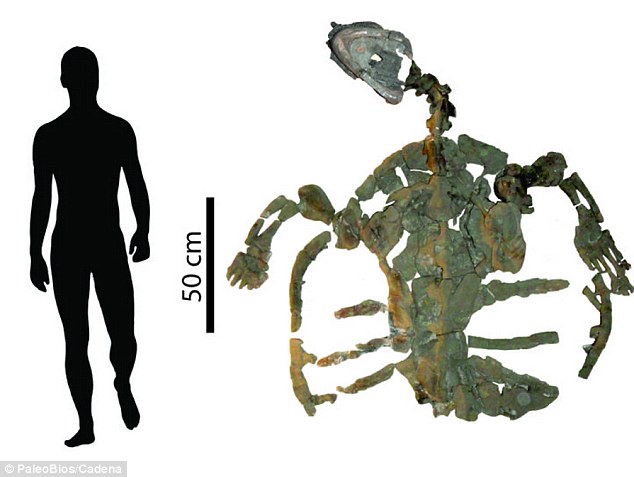The world’s oldest fossilized turtle has been discovered. The turtle dates back to 120 million years ago — this is 25 million years older than the previous record-holder. The age of the specimen is not the only thing impressive. Remarkably, the turtle’s skeleton is almost completely preserved. The species of the ancient turtle is called Desmatochelys padillai and would have looked very similar to modern marine turtles, although this specimen measures more than six and a half feet (two meters) long.
The discovery, which actually includes an almost complete skeleton, several fossilized turtle shells, and individual bones, was made in two sites located near the community in Villa de Leyva, Columbia.
The previously oldest known turtle specimen was from the Santanachelys gaffneyi group. That turtle had been discovered back in 2008, in Brazil. Again, although this species does resemble modern turtles, this particular species had distinguishable digits at the tip of its forearms — a distinct difference from its modern cousins.
“We have discovered a fossil sea turtle from Colombia that is about 25 million years older,” Dr. Edwin Cadena remarked during an interview on the new discovery and on the previous turtle discovered. Dr. Cadena is a scholar of the Alexander von Humboldt Foundation at the Senckenberg Research Institute.
It was he and his colleague J. Parham, from California State University in Fullerton, who found the age of the fossilized turtle. “The turtle described by us as Desmatochelys padillai sp. originates from Cretaceous sediments and is at least 120 million years old,” Dr. Cadena explained.
This find is important for researchers to understand when and how turtles evolved; it is believed that today’s sea turtles are the descendants of terrestrial and freshwater turtles that lived approximately 230 million years ago. Then, during the Cretaceous period, those ancient turtles split into distinct land and sea dwellers.
The exact time of the split is difficult to verify, however, and this is mostly due to the lack of fossil evidence dating from the Cretaceous period. The more fossils that researchers can find, the more complete timeline they can formulate.
The turtle species recovered in Columbia is believed to be related to modern turtles that dwell in tropical and subtropical oceans, including such species as the modern Hawksbill Turtle and the Green Sea Turtle – the very same Green Sea Turtle that is frequently used in turtle soup.
Interestingly, the remains — the shells and bones — had been discovered and collected by hobby paleontologist Mary Luz Parra and her brothers Juan and Freddy Parra in 2007. The remains were then stored in the collections of the Centro de Invetigaciones Paleontológicas, located in Villa Leyva, and the Museum of Paleontology, located at the University of California.
When Dr. Cadena and J. Parham examined the remains, specifically the almost complete skeleton, four skulls, and two partially preserved shells, they placed the fossils in the turtle group called Chelonioidea. This decision was informed by the presence of various morphological characteristics.
“Based on the animals’ morphology and the sediments they were found in, we are certain that we are indeed dealing with the oldest known fossil sea turtle,” Dr. Cadena explained. Their studies and subsequent theories were published in the scientific journal PaleoBios.
Cadena went on the emphasize this and any future finds of turtles. “This lends a special importance to every fossil discovery that can contribute to clarifying the phylogeny of sea turtles.” In laymen’s terms, every discovery, no matter how small or incomplete, will aid in researchers’ understanding of the evolution of sea turtles.
If that discovery has not been enough to satisfy the readers’ interest, there was another discovery made recently. This one, however, is that of a fossilized monkey. The remains were found in an underwater cave located in the Caribbean.
The Latin name for the monkey species is Antillothrix bernensis, although the species is more often referred to as the Hispaniola Monkey, they are thought to have gone extinct in the 16th century. Although the cause of their extinction is unclear, it was most likely related to the settlement of Hispaniola, known as the Dominican Republic now, by Europeans in 1492. Unlike the aforementioned turtles, scientists have found that this monkey species’ morphology — the body shape — has not changed much over the million years of its existence.
